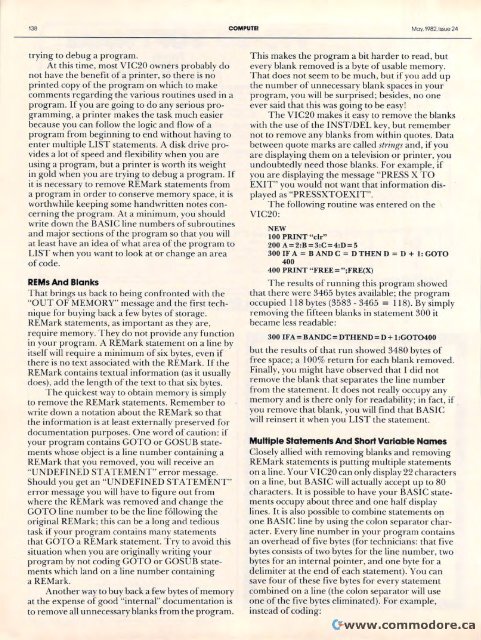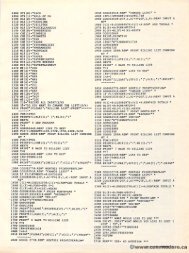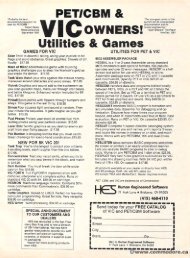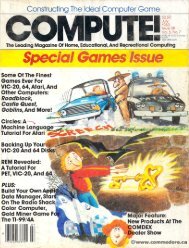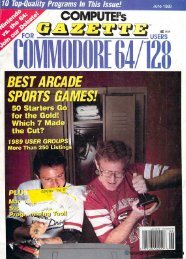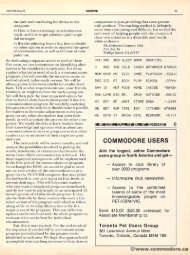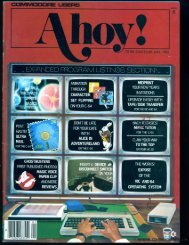Create successful ePaper yourself
Turn your PDF publications into a flip-book with our unique Google optimized e-Paper software.
138 COMPUTEI COMPUTE! Mov. May, 1Q82.lssue 1982. Issue 24<br />
trying to debug a program.<br />
At this time, most VIC2D own ers probably do<br />
At this time, most VIC20 owners probably do<br />
not have the benefit of a printer, so there is no<br />
printed copy of the program on which to make<br />
printed copy of the program on which to make<br />
comments regarding the various routines used in a<br />
program. If youu are going to do any serious programming,<br />
a printer lTlakes makes the task much easier<br />
because you can follow the logic and flow of a<br />
program from beginning to end without having to<br />
enter multiple LIST statements. A disk drive provides<br />
a lot of speed and flexibility when you are<br />
using a program, but a printer is worth its weight<br />
using a program, but a printer is worth its weight<br />
in gold when you are tryingg to debug a program. If<br />
it is necessary to remove REMark statements from<br />
a program in order to conserve memory space, it is<br />
a program in order to conserve memory space, it is<br />
worthwhile keeping some handwritten notes concerning<br />
the program. At a minimum, you should<br />
write downn the BASIC line numbers of subroutines<br />
and majorr sections of the program so that you will<br />
at least have an idea of what area of the program to<br />
LIST when you want to look at or change an area<br />
of code.<br />
REMs And Blanks<br />
That brings us back to being confronted with the<br />
"OUT OFF MEMORY" message and the first technique<br />
for buyingg back k a few bytes of storage.<br />
REMark statements, as important as they are,<br />
require memory. They do not provide any function<br />
require memory. They do not provide any function<br />
in your program. A REMark statement on a line by<br />
itself will require a minimum of six bytes, even if<br />
there is no text associated with the REMark. If the<br />
REMark contains textual information (as it usually<br />
y<br />
does), add the length of the text to that six bytes.<br />
does), add the length of the text to that six bytes.<br />
The quickest way to obtain memory is simply<br />
The quickest way to obtain memory is simply<br />
to remove the REMark statements. Remember to<br />
write down a notation about the REMark so that<br />
the information is at least externally preserved for<br />
the in fo rmation is at least externally preserved fo r<br />
documentation purposes. One word of caution: if<br />
your program contains GOTO or GOSUBB statements<br />
whose object is a line number containing a<br />
REMark that youu removed, , you will receive an<br />
"UNDEFINEDNED STATEMENT" error message.<br />
Should you get an "UNDEFINED NED STATEMENT"<br />
"<br />
error message you will have to figure out from<br />
where the REMark was removed and change the<br />
GOTOO line number to be the line following the<br />
original REMark; ; this cann be a long and tedious<br />
tas laskk if your program contains many statements<br />
that GOTO a REMark statement. Try to avoid this<br />
situation when you are originally writing your<br />
program by not coding GOTOO or GOSUB statements<br />
which land onn a line number containing<br />
a REMark.<br />
Another way to buy back a feww bytes of memory<br />
at the expense of good "internal" documentation is<br />
to remove all all unnecessary blanks from the program.<br />
This makes the program a bit harder to read, , but<br />
every blank removed is a byte of usable memory.<br />
every blank removed is a byte of usable memory.<br />
That does not seem to be much, but if you add up<br />
the number of unnecessary blank spaces in your<br />
the number of unnecessary blank spaces in your<br />
program, youu will be surprised; ; besides, no one<br />
ever said that this was going to be easy!<br />
The VIC2D VIC20 makes it easy to remove the blanks<br />
with the use of the INST/DEL key, but remember<br />
not to remove any blanks from within quotes. Data<br />
between quote marks are called strings and, if you<br />
are displaying them on a television or printer, you<br />
undoubtedly need those blanks. For example, if<br />
you are displaying the message "PRESS X TTOO<br />
EXIT" you would not want that informationn displayed<br />
as "PRESSXTOEXIT".<br />
T he following routine was entered on the<br />
The following routine was entered on the<br />
VIC20: V I C2D:<br />
NEW<br />
100 PRINT "elr"<br />
"clr"<br />
200 A=2:B=3:C=4:D=5<br />
A = = = = 5<br />
300 IF A = BANDC B C = DTHEND D D = D + I 1: : GOTO<br />
400<br />
400 PRINT "FREE = ";FRE(X)<br />
T he results of running this program showed<br />
The results of running this program showed<br />
that there were 3465 bytes available; the program<br />
occupied 118 bytes (3583-3465 = 118). By simply<br />
occupied liS bytes (35S3 - 3465 = liS) . By simply<br />
removing the fifteen blanks in statement 3.0.0 300 it<br />
became less readable:<br />
300 IFA=BANDC=DTHEND=D+ I:GOT0 400<br />
300 IFA = BANDC = DTHEND = D + 1 :GOTO400<br />
but the results of that run showed 34SD 3480 bytes of<br />
free space; a 1.0.0% 100% return for each blank removed. .<br />
Finally, you might have observed that I did not<br />
remove the blank that separates the line number<br />
from the statement. I Itt does not really occupy any<br />
memory and is there only for readability; readability: in fact, if<br />
you remove that blank, you will find that BASIC<br />
will reinsert it when you LIST the statement.<br />
Multiple statements Statements And Short Variable Names<br />
Closely allied with removing blanks' and removing<br />
REMark statements is putting multiple statements<br />
on a line. Your VIC2D VIC20 cann onlyy display 22 characters<br />
on a line, but BASICC will actuallyy accept up to 8.0 80<br />
characters. It is possible to have your BASIC statements<br />
occupy about three and one half display<br />
lines. It is also possible to combine statements on<br />
one BASIC line by using the colon separator ch'aracter.<br />
Every line number in your program contains<br />
an overhead of fivee bytes (for technicians: that five<br />
bytes consists of two bytes for the line number, two<br />
bytes for r an internal pointer, and one byte for a<br />
delimiter at the end of each statement). You cann<br />
save four of these fivee bytes for every statement<br />
combined on a line (the colonn separator will use<br />
char<br />
one of the five bytes eliminated). For example,<br />
instead of coding:


